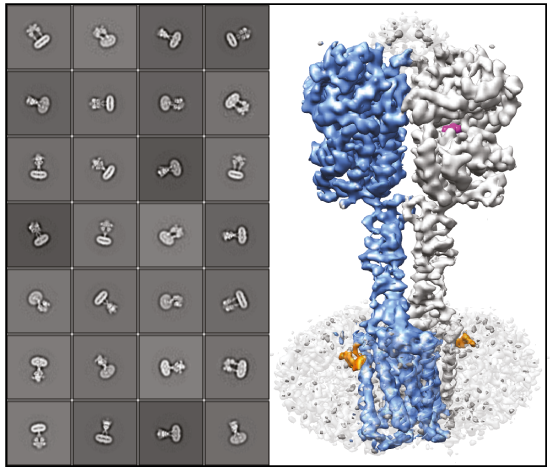
LE FONCTIONNEMENT DE RÉCEPTEURS CLÉS DE LA COMMUNICATION NEURONALE DÉCODÉ
De nombreuses pathologies du système nerveux central, comme l’autisme, la maladie de Parkinson, la schizophrénie, l’anxiété ou encore la dépression, sont liées au dysfonctionnement des neurotransmetteurs et de leurs récepteurs. La mise au point de médicaments ou de thérapies contre ces dysfonctionnements nécessite une meilleure compréhension moléculaire et chimique des mécanismes d’activation des récepteurs des neurotransmetteurs. C’est chose faite pour l'un des récepteurs du glutamate, le principal neurotransmetteur excitateur du cerveau, grâce à une collaboration entre la France, l’Inde et l’Angleterre. Ces résultats, publiés dans la revue Cell Reports, ont permis de mettre en évidence certaines structures moléculaires qui contrôlent la transmission du signal entre les neurones.
Le cerveau humain est composé de milliards de neurones interconnectés par les synapses. Les réseaux de communication neuronaux ainsi formés sont fondamentaux pour les fonctions cérébrales telles que les processus d’apprentissage ou la mémoire. Les synapses sont le lieu d’échanges des molécules de la communication entre les neurones, aussi appelées neurotransmetteurs, tels que le glutamate. Le glutamate, libéré dans la synapse, est capté par des récepteurs membranaires qui participent à la modulation de l’activité neuronale. Parmi ceux-ci, le récepteur métabotropique du glutamate de sous type 5, mGlu5, joue un rôle clé dans le fonctionnement synaptique. Son dysfonctionnement étant associé à plusieurs pathologies du système nerveux central, tels que l’autisme, les douleurs chroniques, la maladie de Parkinson ou encore la schizophrénie, comprendre ses mécanismes d’activation à l’échelle atomique est essentiel pour mettre au point de nouveaux médicaments pour traiter ces maladies.
En collaboration avec une équipe du National Centre for Biological Sciences, Tate Institute of Fundamental Research (NCBS-TIFR, Bangalore, Inde), du Laboratory of Molecular Biology du Medical Research Council (MRC-LMB, Cambridge, Angleterre), du Paul Scherrer Institute en Suisse (PSI, Villigen, Suisse), et du Laboratory of Medicinal Chemistry and Synthesis (MCS, Barcelone, Espagne), l’équipe de Guillaume Lebon de l’Institut de génomique fonctionnelle (CNRS/INSERM/Université de Montpellier) a résolu la structure tridimensionnelle du récepteur mGlu5 lié à des agents chimiques modulant son activité.
Grâce à la microscopie en condition cryogénique sur les microscopes du LMB de Cambridge, ils ont étudié la diversité des changements de conformation qui permettent la transmission du message chimique par le récepteur mGlu5, phénomène appelé transduction du signal. Ils ont ensuite décomposé le fonctionnement moléculaire de ce récepteur et de son domaine membranaire encore plus en détails en combinant la cristallographie des rayons X et l’utilisation d’un modulateur photosensible qui permet de contrôler l’activité du récepteur avec la lumière. Ces structures tridimensionnelles et l’analyse fonctionnelle réalisée en collaboration entre les chercheurs de l’IGF, du Centre de biochimie structurale (CBS) et l’Institut des biomolécules Max Mousseron (IBMM) de Montpellier ont permis de mettre en évidence les bases structurales et moléculaires qui contrôlent l’équilibre des conformations responsables de la transduction du signal. Ces résultats ont été publiés dans la revue Cell Reports et devraient aider à lutter contre les pathologies du système nerveux central dans lesquelles le récepteur est impliqué.
Structure 3D du neurorécepteur métabotropique du glutamate humain de sous type 5, mGlu5, obtenue en cryo-microsocpie électronique. © Guillaume Lebon
Référence
Agonists and allosteric modulators promote signaling from different metabotropic glutamate receptor 5 conformations
Chady Nasrallah, Giuseppe Cannone, Julie Briot, Karine Rottier, Alice E. Berizzi, Chia-Ying Huang, Robert B. Quast, Francois Hoh, Jean-Louis Bane'res, Fanny Malhaire, Ludovic Berto, Anaëlle Dumazer, Joan Font-Ingles, Xavier Gómez-Santacana, Juanlo Catena, Julie Kniazeff, Cyril Goudet, Amadeu Llebaria, Jean-Philippe Pin, Kutti R. Vinothkumar* and Guillaume Lebon1*, Cell Reports 31 août 2021.
Lien Publication
THE FUNCTIONING OF KEY NEURONAL COMMUNICATION RECEPTORS DECODED
The human brain is composed of billions of neurons interconnected by synapses. The neural communication networks thus formed are fundamental to brain functions such as learning processes or memory. Synapses are the site of exchange of communication molecules between neurons, also known as neurotransmitters, such as glutamate. Glutamate, released in the synapse, is taken up by membrane receptors that participate in the modulation of neuronal activity. Among these, the metabotropic subtype 5 glutamate receptor, mGlu5, plays a key role in synaptic function. As its dysfunction is associated with several pathologies of the central nervous system, such as autism, chronic pain, Parkinson's disease and schizophrenia, understanding its activation mechanisms at the atomic level is essential for developing new drugs to treat these diseases.
In collaboration with a team from the National Centre for Biological Sciences, Tate Institute of Fundamental Research (NCBS-TIFR, Bangalore, India), the Medical Research Council Laboratory of Molecular Biology (MRC-LMB, Cambridge, England), the Paul Scherrer Institute in Switzerland (PSI, Villigen, Switzerland), and the Laboratory of Medicinal Chemistry and Synthesis (MCS, Barcelona, Spain), Guillaume Lebon's team from the Institute of Functional Genomics (CNRS/INSERM/University of Montpellier) has solved the three-dimensional structure of the mGlu5 receptor linked to chemical agents modulating its activity.
Using microscopy under cryogenic conditions on microscopes at the LMB in Cambridge, they studied the diversity of conformational changes that allow the transmission of the chemical message by the mGlu5 receptor, a phenomenon called signal transduction. They then broke down the molecular functioning of this receptor and of its membrane domain in even greater detail by combining X-ray crystallography with the use of a light-sensitive modulator that allows the activity of the receptor to be controlled with light. These three-dimensional structures and the functional analysis carried out in collaboration between researchers from the IGF, the Centre for Structural Biochemistry (CBS) and the Max Mousseron Institute of Biomolecules (IBMM) in Montpellier have made it possible to highlight the structural and molecular bases that control the equilibrium of the conformations responsible for signal transduction. These results were published in the journal Cell Reports and should help to combat the central nervous system pathologies in which the receptor is involved.






